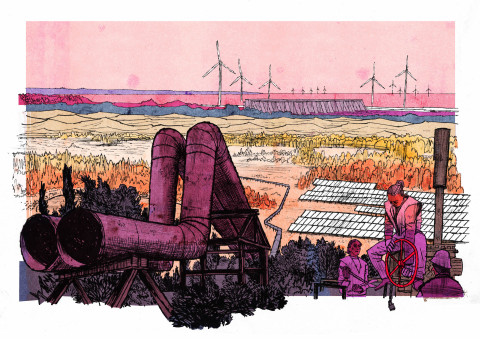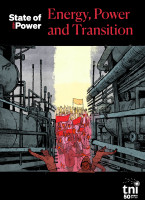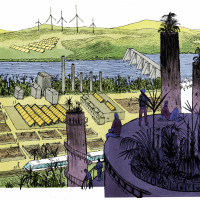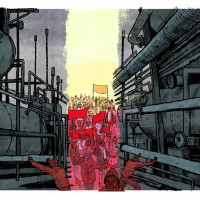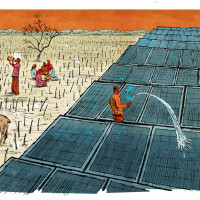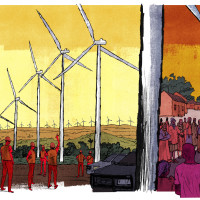A few years ago, there was much talk of fossil fuel companies investing big in renewable energy. BP’s new chief executive announced in 2020, for instance, that the company would cut future fossil fuel production by 40%, and boost its capacity to generate electricity from renewable sources to 50 gigawatts (GW), a 20-fold increase.16 There is cause for deep scepticism about the durability of these investments, particularly since BP famously rebranded itself Beyond Petroleum in 2001 but then killed its research programs on green energy and locked away the research in a private corporate archive.17 Its 2020 conversion to renewables was not to last: when BP abandoned its plans to reduce oil and gas output early in 2023, its share prices surged. It’s not alone. Overall, oil and gas companies spent less than 5 percent of their production and exploration investments on low-emission energy sources in recent years, according to the International Energy Agency.18
But fickleness is not the only reason why the energy transition should not be left in the hands of fossil capital. As Andreas Malm has shown, through combustion of fossil fuels, fossil capital was able to delink energy production from natural sources such as the sun and wind, and consequently to concentrate the working class in urban factories, where they could be squeezed for maximum profit.19 This strategy and the enormous energy generated by fossil fuels produced unmatched capital accumulation – but it also created unprecedented and catastrophic environmental destruction, including carbon emissions. These oppressive characteristics will not simply dissolve if fossil capital shifts investments to renewable energy. As Tatjana Söding argues, fossil capital is intrinsically committed to exploitation and environmental destruction: ‘Since fossil capital, in the dynamics of its original accumulation, firstly created abstract space and time, secondly maximized its control over global labor power in order to enable a high(er) degree of capital accumulation, and thirdly created natural destruction as a necessary by-product, its switch to renewable energy must not be understood as a relief from these intentional by-products’.20 Söding suggests that we should not leave energy transition up to fossil fuel companies like BP, given they are grounded in deeply destructive exploitation of workers and the environment, as well as their megalomaniacal orientation created by access to virtually unlimited reserves of fossil energy.
In the early months of our organising, the Public Power campaign discovered that the destructive dynamics that characterise Big Oil are also central to for-profit electricity utilities. PPNY began in late 2019 with a campaign organised by the New York City branch of the Democratic Socialists of America (DSA) against a proposed hike in electricity rates by for-profit utility ConEd. As in other states across the US, the charges consumers pay to utilities for electricity in New York are regulated by the politically appointed bodies called the Public Service Commission (PSC). But although the PSC is supposed to keep rates affordable, researchers with the campaign found that ConEd was already charging the second-highest residential rates in the country. In addition, despite raking in mega-profits, ConEd and gas utilities like National Grid routinely threatened to cut off power to low-income customers.
And it wasn’t just that the utility behaved in a patently unjust manner. Public Power researchers discovered that National Grid and other for-profit utilities have a structural incentive to build as much infrastructure as possible to justify their requests for rate hikes. This is because gas utilities receive so-called ‘line extension subsidies’, money collected from energy consumers to pay for additional gas pipelines. This arrangement essentially means that for-profit utilities force ordinary people to pay them to lock in fossil infrastructure.
The exploitative and environmentally destructive character of this aspect of fossil capital became even clearer when our campaign discovered that ConEd pays USD 1.4 million in annual dues to trade associations like the Edison Electric Institute and the American Gas Association, which lobby to undermine renewable energy, to deregulate the energy market, and to consolidate power for private utilities. This information and our analysis of the structural incentives that lead for-profit utilities to build fossil infrastructure made it plain to the Public Power campaign that a rapid and just energy transition could be won by only a democratically controlled public authority.
The racist character of fossil capital was made clear when New York City was struck with a heat wave during the summer after the campaign against rate hikes kicked off. In the middle of this heat wave, ConEd cut power to working-class communities of colour in the city’s outer boroughs in order to protect the power supplies to wealthier communities across the city.21 Communities in places like East New York tend not only to be poorer but also to have less access to cool green spaces and air conditioning, which contributes to higher heat-related mortality rates. Cutting off their power was a chilling instance of the creation of ‘sacrifice zones’ in racialised communities. After these incidents, the Public Power campaign canvassed areas that had been hit by power cut-offs and held town hall-style meetings across the city, explaining that the struggle for democratically controlled power was the solution to unaffordable electricity rates and the injustice of cutting off power.
A huge question the Public Power campaign faced was how to build an alternative to the for-profit utilities. After all, corporations like ConEd, which has been around in one form or another since the construction of the modern grid, wield immense economic and political power. Fortunately, in New York State there is an alternative source of power: the New York Power Authority (NYPA). Established during the Depression, NYPA was conceived by then-governor Franklin Delano Roosevelt as a public alternative to the price-gouging private utilities of that era. Although NYPA generates roughly 20% of the state’s clean power through its hydropower plants on the Great Lakes, its capacity to build new renewable energy was limited by law prior to the passage of the BPRA. Our research into NYPA convinced us that it could build renewable energy projects cheaper, faster, and more efficiently than the for-profit sector. Unlike for-profit energy firms, for example, NYPA is not bound to generate astronomical returns for investors. In addition, because of its high bond rating, NYPA can borrow money at very low interest to fund projects. This means that it does not have to raise utility rates to build infrastructure, as investor-owned utilities do. Renewable energy development led by NYPA could avoid intensifying the energy poverty that our campaign was initially launched to address.
Organisers with experience of fighting for energy democracy in New York realised that the Public Power campaign needed to work on a state-wide scale to win the legislation we needed to empower NYPA with a mandate to build new renewables. The campaign decided to organise a broad popular movement for Public Power, and also to work with socialists and other allies within the state legislature to push forward the BPRA. We formed the state-wide public power coalition in late 2019, pulling together energy democracy activists, environmental justice groups, and climate organisations like the Sunrise Movement. Early in 2020, we began the collaborative process of investigating how public power legislation could meet diverse needs across the state, and we also started a state-wide series of Energy 101 public events to educate people about the injustice and dismal performance of the for-profit utility system. During the pandemic, our victories showed that Public Power was a force to be reckoned with: we organised successfully for a moratorium on electricity shut-off and for cancellation of utility debt for communities hard-hit by COVID-19.
We fought hard for the BPRA, but saw it languish in legislative committees for two consecutive years. This showed us that we had to keep building public pressure. We organised public protests, including a rally in which we called out legislators taking money from corporate utilities and – not coincidentally – opposing the BPRA. Our electoral campaign organised key legislators, who then helped organise less politically progressive people in the legislature to back the BPRA. We also undertook direct action protest, in which people demanding public power locked down in a human chain across Broadway in downtown Manhattan, just near the offices of key state legislators.
Key to amassing the political power necessary to pass the BPRA was winning over organised labour. While the working class in general stands to benefit from democratic control of the means of energy production, workers are not a homogeneous group in relation to energy transition. Indeed, contrary to Matt Huber’s arguments about unified class struggle against the capitalist drivers of the climate crisis, we found that some labour unions initially rejected our appeals to join in the campaign for public power – while others signed on enthusiastically.22 Early endorsement from my own union, the Professional Staff Congress of the City University of New York, led to subsequent support from the New York State Teachers Union (NYSUT) and other unions in the service sector such as 1199SEIU. Winning over the unions took additional work, given the scepticism of workers in these sectors about the (largely private) renewable energy industry in the US, which is notoriously anti-union. To address these concerns, we worked with the AFL-CIO to incorporate gold-standard labour language into the BPRA that includes prevailing wage and project labour agreement provisions, a labour transition memorandum of understanding (MoU), and USD 25 million in annual funding for an Office of Just Transition to oversee retraining of workers in the renewable energy field.
The final version of the BPRA that passed in May 2023 included most of the key provisions for which we had long fought. NYPA was, at long last, mandated to build, own, and operate renewable energy projects. Each year, NYPA must conduct a review to determine whether the state is on track to reach 70% renewable power by 2030 and 100% by 2040, according to state mandates. If not, NYPA must step in to build enough energy to make up the difference. The BPRA also requires NYPA to phase it out its fossil fuel power plants – including dirty peaker plants (backup power plants turned on when electricity peaks) located predominantly in communities of colour – by 2030, and to provide and deliver only renewable energy to customers. These peaker plants lie idle most of the time, only coming into service at moments of peak demand – and therefore are grandfathered out of most environmental regulations. Shutting down these polluting peaker plants is a major victory of our campaign. BPRA law also requires NYPA to establish a programme allowing low- and moderate-income electricity customers to receive credits on their monthly utility bills for any renewable energy produced by NYPA. Finally, the BPRA includes all the pro-labour language that the Public Power campaign crafted in collaboration with union allies.
Now that we’ve won this mandate, we must keep fighting for adequate implementation of he BPRA. The situation is challenging. As a legacy of fossil capital’s long history of fighting against energy transition, New York State will have to add 2.5 GW per year for the next eight years to meet climate goals of 70% renewable energy by 2030.23 To put that in perspective, the state has only added 12.9 GW of energy in general (both fossil and renewable) over the last 20 years, or roughly 0.645 GW per year. This steep increase is just to decarbonise the energy grid. To generate enough energy to power a fleet of electric vehicles and to decarbonise the heating and cooling of buildings and manufacturing, we must roughly triple the current amount of power generation.
Campaigners with Public Power NY were of course highly aware of the need to promote energy efficiency. Expanding energy production – even if it’s renewable – is already having many damaging downstream environmental impacts, including, for example, mining in low-income countries such as Bolivia. While the campaign was aware of the consequent need to promote energy efficiency, we did not include such measures in the BPRA both because of the need to keep the legislation focused, and because the state already had trend-setting energy efficiency legislation on the books. New York City’s Local Law 97, which passed in 2019, mandates emissions cuts of 40% from the city’s largest buildings by 2030, and up to 80% by 2040.24
Conducting the rapid, large-scale development of renewable power mandated by the Climate Act of 2019 in a democratic and just fashion will be a massive challenge. Fortunately, the BPRA established a strategic planning process through which NYPA is directed to determine where, when, and how it builds renewable power. Although we did not win all our demands for democratisation of NYPA, this strategic planning process is a site for substantial community input since the authority is required to consult with climate and resiliency experts, labour organisations, residential and small business ratepayer advocates, and environmental justice communities, among others, as it draws up its strategic plans. To ensure that NYPA faithfully carries out this mandate of community engagement, I am currently organising a Public Power Observatory that will monitor the authority’s work, document its history, and engage in various forms of creative public outreach concerning the energy transition.


